Hit-type cameras
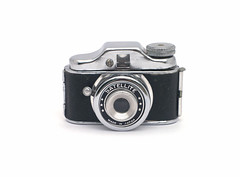
|
| Satellite, an example of Hit type camera. image by Steve Harwood (Image rights) |
After WWII the Japanese had a period of low spending capacity. So they enjoyed using cameras which didn't use much film material, making 14×14mm exposures on narrow paper-backed 17.5mm film. This kept film costs affordable. The main design used for most of these cameras was that of a miniature version of a simple contemporary 35mm viewfinder camera, with leatherette covered body, chrome plated parts, a film advance control window in the back and a characteristic top with a simple viewfinder and film advance knob. Most of these cameras had a non-focusable lens with fixed small aperture, an everset shutter with bulb and instant mode. The original idea to make such 17.5mm viewfinder cameras was introduced in 1937 with the Midget, certainly invented by Nakamura Jirō, followed in 1939 by the Mycro, but the vast majority of the models appeared in the late 1940s and early 1950s.
One of the most successful models was the Hit, made by the Tougodo company based in Toyohashi. Its name became the synonym for that camera type, at least in the Western world, where the various other Japanese cameras with a similar design are called "Hit"-type cameras. In Japan, these are called mame kamera (豆カメラ), literally "bean cameras". Only the cheapest of these cameras were similar to Tougodo's Hit, the heavier and more evolved models were actually inspired by the Midget and Mycro.
Many of the Hit-type cameras were exported to the US and turned into cash. They were revealed to the US public by the magazine US Camera in September 1946 — this was before the release of the Hit, and the featured camera was certainly the Mycro, the first such camera to reach the market after 1945.[1] It is said that more publicity was given when one of these cameras was offered to Marlene Dietrich by a US soldier back from Japan.[1] The demand from the US grew rapidly, and a business model emerged in Japan, with no less than 18 manufacturers and about 50 subcontractors involved in Hit-type camera production in 1949.[1] The sales reached a peak that year, with 188,500 units sent for export, generating nearly 800 million yen.[1] It is said that many of these cameras, not seriously considered for picture taking, were used as toys or Christmas tree ornaments.[2] The sales were very seasonal, with 65,000 cameras, or about one third, bought in June and July 1949 in anticipation for Christmas.[1] By 1950, the trend for such novelty cameras was already declining, with about 50,000 units exported in the same period of the year.[1] On the Japanese user market, better subminiature cameras using 16mm film began to displace the 17.5mm film cameras.
Production of cheap Hit-type cameras nonetheless continued for a long time. Various cameras were made with a more modern design, adapting the original Hit concept. Some were made by Tougodo itself, such as the Baby-Max and Toyoca Ace, and others were probably made by different companies, such as the Homer No.1 or Bell 14.
Beginning sometime in the late 1950s and continuing at least through the 1970s, Hit-type cameras were advertised for sale in the novelty toy ads of many boys' magazines in the US and other countries. These cameras were sold as "Miniature Secret Cameras", "Midget Spy Cameras", "Secret Agent Spy Cameras", etc, alongside myriad other novelty toys such as joy buzzers, hot pepper gum, and sneezing powder. The most well-known supplier of novelty toys during this period, including Hit-type cameras, was the Johnson Smith Company, although many other toy suppliers sold these cameras as well.
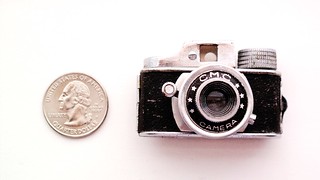
|
| CMC Camera image by Erin Zieske (Image rights) |
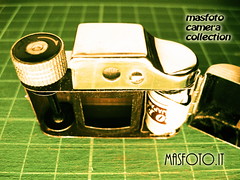
|
| unbelievable: Rollfilm could be loaded into the micro cameras image by Mas Foto (Image rights) |
Notes
- ↑ 1.0 1.1 1.2 1.3 1.4 1.5 "Mame kamera hakusho", column by Haga Hideo in Asahi Camera July 1950 reproduced in Kokusan kamera no rekishi, p.189.
- ↑ Used as Christmas tree ornaments: Sugiyama, p.288.
Bibliography
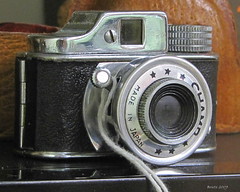
|
| Champ image by realbruts! (Image rights) |
- Haga Hideo (芳賀日出男). "Mame kamera hakusho" (豆カメラ白書, White paper on bean cameras). In Asahi Camera July 1950, reproduced in Kokusan kamera no rekishi, p.189.
- McKeown, James M. and Joan C. McKeown's Price Guide to Antique and Classic Cameras, 12th Edition, 2005-2006. USA, Centennial Photo Service, 2004. ISBN 0-931838-40-1 (hardcover). ISBN 0-931838-41-X (softcover). (Notably features a list of name variants on p.391.)
- Pritchard, Michael and St. Denny, Douglas. Spy Cameras — A century of detective and subminiature cameras. London: Classic Collection Publications, 1993. ISBN 1-874485-00-3. Pp.74–9.
- Sugiyama, Kōichi (杉山浩一); Naoi, Hiroaki (直井浩明); Bullock, John R. The Collector's Guide to Japanese Cameras. 国産カメラ図鑑 (Kokusan kamera zukan). Tokyo: Asahi Sonorama, 1985. ISBN 4-257-03187-5. P.288.
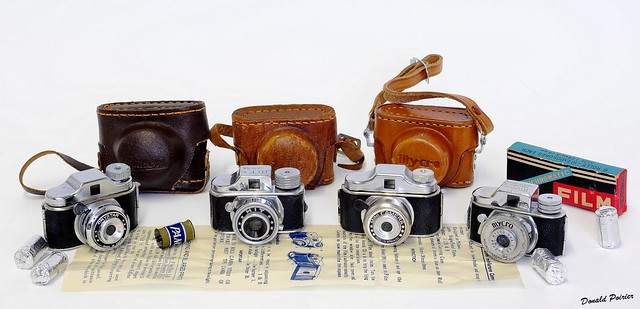
|
| image by Donald Poirier (Image rights) |
Links
In English:
- 17.5mm cameras at Submin.com, listing over 450 variations in Hit type cameras
- Collecting Hit-type cameras (archived), article by Tim Goldsmith in ePhotoZine
- Hit at the Subminiature site of Gary Sivertsen, with links to pages of the same site presenting other Hit type cameras
In German:
- Enorme Typenvielfalt: Minis aus Fernost (archived), article by Hubert E. Heckmann in Photodeal.de
In Swedish:
- Hit-type cameras (archived) at Fotomuseet i Osby
